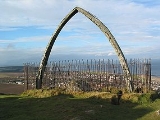
North Berwick Law
Encyclopedia
North Berwick Law is a conical hill which rises incongruously from the surrounding landscape (indeed, this is the definition of the Lowland Scots
word "law"). It overlooks the East Lothian
town of North Berwick
and stands at 613 ft (187 m) above sea level.
Geologically, the law is a volcanic plug
of hard phonolitic
trachyte
rock of Carboniferous
(Dinantian
) age. It has survived the scraping glaciers of the ice age
. It is a crag and tail
with a prominent tail extending eastwards.
The summit also bears some ancient ruins. These buildings were once used by lookouts in the Napoleonic Wars
.
The famous whale's jawbone, pictured below right, collapsed in June 2005 after rotting away, and was removed by helicopter, much to the surprise of North Berwick residents. A jawbone has stood there since 1709, the last one having been there since 1933.
On 26 June 2008, a fibreglass replica whale bone, the same size as the one that was removed in 2005, was airlifted into place to give North Berwick Law back its famous landmark.
Scots language
Scots is the Germanic language variety spoken in Lowland Scotland and parts of Ulster . It is sometimes called Lowland Scots to distinguish it from Scottish Gaelic, the Celtic language variety spoken in most of the western Highlands and in the Hebrides.Since there are no universally accepted...
word "law"). It overlooks the East Lothian
East Lothian
East Lothian is one of the 32 council areas of Scotland, and a lieutenancy Area. It borders the City of Edinburgh, Scottish Borders and Midlothian. Its administrative centre is Haddington, although its largest town is Musselburgh....
town of North Berwick
North Berwick
The Royal Burgh of North Berwick is a seaside town in East Lothian, Scotland. It is situated on the south shore of the Firth of Forth, approximately 25 miles east of Edinburgh. North Berwick became a fashionable holiday resort in the 19th century because of its two sandy bays, the East Bay and the...
and stands at 613 ft (187 m) above sea level.
Geologically, the law is a volcanic plug
Volcanic plug
A volcanic plug, also called a volcanic neck or lava neck, is a volcanic landform created when magma hardens within a vent on an active volcano. When forming, a plug can cause an extreme build-up of pressure if volatile-charged magma is trapped beneath it, and this can sometimes lead to an...
of hard phonolitic
Phonolite
Phonolite is a rare igneous, volcanic rock of intermediate composition, with aphanitic to porphyritic texture....
trachyte
Trachyte
Trachyte is an igneous volcanic rock with an aphanitic to porphyritic texture. The mineral assemblage consists of essential alkali feldspar; relatively minor plagioclase and quartz or a feldspathoid such as nepheline may also be present....
rock of Carboniferous
Carboniferous
The Carboniferous is a geologic period and system that extends from the end of the Devonian Period, about 359.2 ± 2.5 Mya , to the beginning of the Permian Period, about 299.0 ± 0.8 Mya . The name is derived from the Latin word for coal, carbo. Carboniferous means "coal-bearing"...
(Dinantian
Dinantian
Dinantian is the name of a series or epoch from the Lower Carboniferous system in Europe. It can stand for a series of rocks in Europe or the time span in which they were deposited....
) age. It has survived the scraping glaciers of the ice age
Ice age
An ice age or, more precisely, glacial age, is a generic geological period of long-term reduction in the temperature of the Earth's surface and atmosphere, resulting in the presence or expansion of continental ice sheets, polar ice sheets and alpine glaciers...
. It is a crag and tail
Crag and tail
A crag is a rocky hill or mountain, generally isolated from other high ground. Crags are formed when a glacier or ice sheet passes over an area that contains a particularly resistant rock formation...
with a prominent tail extending eastwards.
The summit also bears some ancient ruins. These buildings were once used by lookouts in the Napoleonic Wars
Napoleonic Wars
The Napoleonic Wars were a series of wars declared against Napoleon's French Empire by opposing coalitions that ran from 1803 to 1815. As a continuation of the wars sparked by the French Revolution of 1789, they revolutionised European armies and played out on an unprecedented scale, mainly due to...
.
The famous whale's jawbone, pictured below right, collapsed in June 2005 after rotting away, and was removed by helicopter, much to the surprise of North Berwick residents. A jawbone has stood there since 1709, the last one having been there since 1933.
On 26 June 2008, a fibreglass replica whale bone, the same size as the one that was removed in 2005, was airlifted into place to give North Berwick Law back its famous landmark.
External links
- Computer-generated virtual panoramas North Berwick Law
- Stuart McHardy, The Goddess in the Landscape of Scotland

